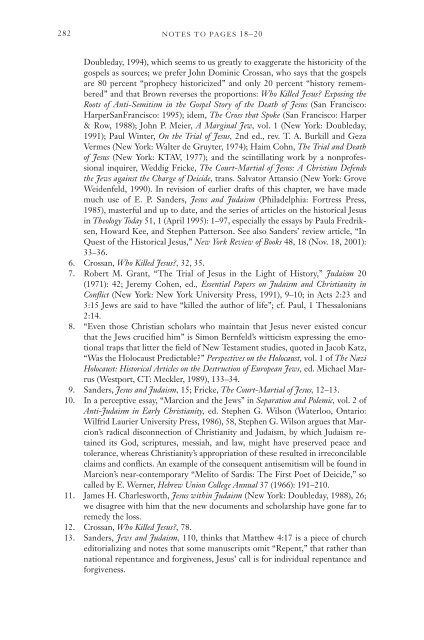Anti-semitism: Myth and Hate from Antiquity to the Present
Anti-semitism: Myth and Hate from Antiquity to the Present
Anti-semitism: Myth and Hate from Antiquity to the Present
You also want an ePaper? Increase the reach of your titles
YUMPU automatically turns print PDFs into web optimized ePapers that Google loves.
282 NOTES TO PAGES 18–20<br />
Doubleday, 1994), which seems <strong>to</strong> us greatly <strong>to</strong> exaggerate <strong>the</strong> his<strong>to</strong>ricity of <strong>the</strong><br />
gospels as sources; we prefer John Dominic Crossan, who says that <strong>the</strong> gospels<br />
are 80 percent “prophecy his<strong>to</strong>ricized” <strong>and</strong> only 20 percent “his<strong>to</strong>ry remembered”<br />
<strong>and</strong> that Brown reverses <strong>the</strong> proportions: Who Killed Jesus? Exposing <strong>the</strong><br />
Roots of <strong>Anti</strong>-Semitism in <strong>the</strong> Gospel S<strong>to</strong>ry of <strong>the</strong> Death of Jesus (San Francisco:<br />
HarperSanFrancisco: 1995); idem, The Cross that Spoke (San Francisco: Harper<br />
& Row, 1988); John P. Meier, A Marginal Jew, vol. 1 (New York: Doubleday,<br />
1991); Paul Winter, On <strong>the</strong> Trial of Jesus, 2nd ed., rev. T. A. Burkill <strong>and</strong> Geza<br />
Vermes (New York: Walter de Gruyter, 1974); Haim Cohn, The Trial <strong>and</strong> Death<br />
of Jesus (New York: KTAV, 1977); <strong>and</strong> <strong>the</strong> scintillating work by a nonprofessional<br />
inquirer, Weddig Fricke, The Court-Martial of Jesus: A Christian Defends<br />
<strong>the</strong> Jews against <strong>the</strong> Charge of Deicide, trans. Salva<strong>to</strong>r Attansio (New York: Grove<br />
Weidenfeld, 1990). In revision of earlier drafts of this chapter, we have made<br />
much use of E. P. S<strong>and</strong>ers, Jesus <strong>and</strong> Judaism (Philadelphia: Fortress Press,<br />
1985), masterful <strong>and</strong> up <strong>to</strong> date, <strong>and</strong> <strong>the</strong> series of articles on <strong>the</strong> his<strong>to</strong>rical Jesus<br />
in Theology Today 51, 1 (April 1995): 1–97, especially <strong>the</strong> essays by Paula Fredriksen,<br />
Howard Kee, <strong>and</strong> Stephen Patterson. See also S<strong>and</strong>ers’ review article, “In<br />
Quest of <strong>the</strong> His<strong>to</strong>rical Jesus,” New York Review of Books 48, 18 (Nov. 18, 2001):<br />
33–36.<br />
6. Crossan, Who Killed Jesus?, 32, 35.<br />
7. Robert M. Grant, “The Trial of Jesus in <strong>the</strong> Light of His<strong>to</strong>ry,” Judaism 20<br />
(1971): 42; Jeremy Cohen, ed., Essential Papers on Judaism <strong>and</strong> Christianity in<br />
Conflict (New York: New York University Press, 1991), 9–10; in Acts 2:23 <strong>and</strong><br />
3:15 Jews are said <strong>to</strong> have “killed <strong>the</strong> author of life”; cf. Paul, 1 Thessalonians<br />
2:14.<br />
8. “Even those Christian scholars who maintain that Jesus never existed concur<br />
that <strong>the</strong> Jews crucified him” is Simon Bernfeld’s witticism expressing <strong>the</strong> emotional<br />
traps that litter <strong>the</strong> field of New Testament studies, quoted in Jacob Katz,<br />
“Was <strong>the</strong> Holocaust Predictable?” Perspectives on <strong>the</strong> Holocaust, vol. 1 of The Nazi<br />
Holocaust: His<strong>to</strong>rical Articles on <strong>the</strong> Destruction of European Jews, ed. Michael Marrus<br />
(Westport, CT: Meckler, 1989), 133–34.<br />
9. S<strong>and</strong>ers, Jesus <strong>and</strong> Judaism, 15; Fricke, The Court-Martial of Jesus, 12–13.<br />
10. In a perceptive essay, “Marcion <strong>and</strong> <strong>the</strong> Jews” in Separation <strong>and</strong> Polemic, vol. 2 of<br />
<strong>Anti</strong>-Judaism in Early Christianity, ed. Stephen G. Wilson (Waterloo, Ontario:<br />
Wilfrid Laurier University Press, 1986), 58, Stephen G. Wilson argues that Marcion’s<br />
radical disconnection of Christianity <strong>and</strong> Judaism, by which Judaism retained<br />
its God, scriptures, messiah, <strong>and</strong> law, might have preserved peace <strong>and</strong><br />
<strong>to</strong>lerance, whereas Christianity’s appropriation of <strong>the</strong>se resulted in irreconcilable<br />
claims <strong>and</strong> conflicts. An example of <strong>the</strong> consequent anti<strong>semitism</strong> will be found in<br />
Marcion’s near-contemporary “Meli<strong>to</strong> of Sardis: The First Poet of Deicide,” so<br />
called by E. Werner, Hebrew Union College Annual 37 (1966): 191–210.<br />
11. James H. Charlesworth, Jesus within Judaism (New York: Doubleday, 1988), 26;<br />
we disagree with him that <strong>the</strong> new documents <strong>and</strong> scholarship have gone far <strong>to</strong><br />
remedy <strong>the</strong> loss.<br />
12. Crossan, Who Killed Jesus?, 78.<br />
13. S<strong>and</strong>ers, Jews <strong>and</strong> Judaism, 110, thinks that Mat<strong>the</strong>w 4:17 is a piece of church<br />
edi<strong>to</strong>rializing <strong>and</strong> notes that some manuscripts omit “Repent,” that ra<strong>the</strong>r than<br />
national repentance <strong>and</strong> forgiveness, Jesus’ call is for individual repentance <strong>and</strong><br />
forgiveness.
















